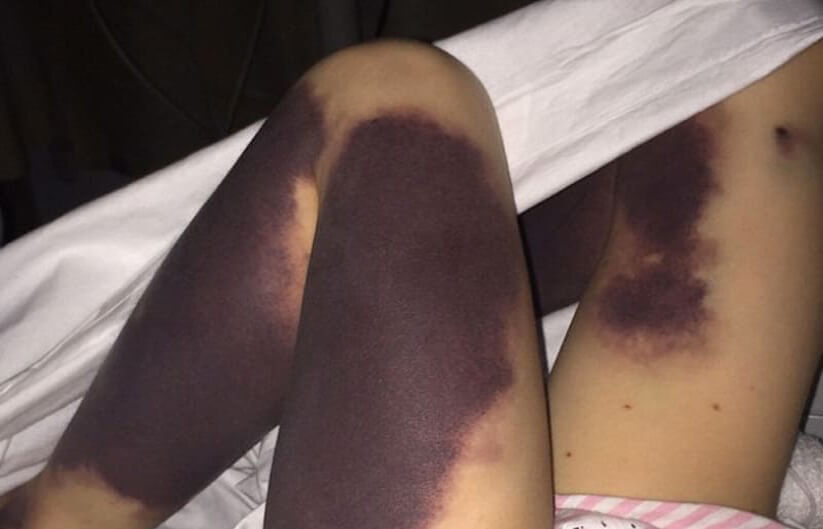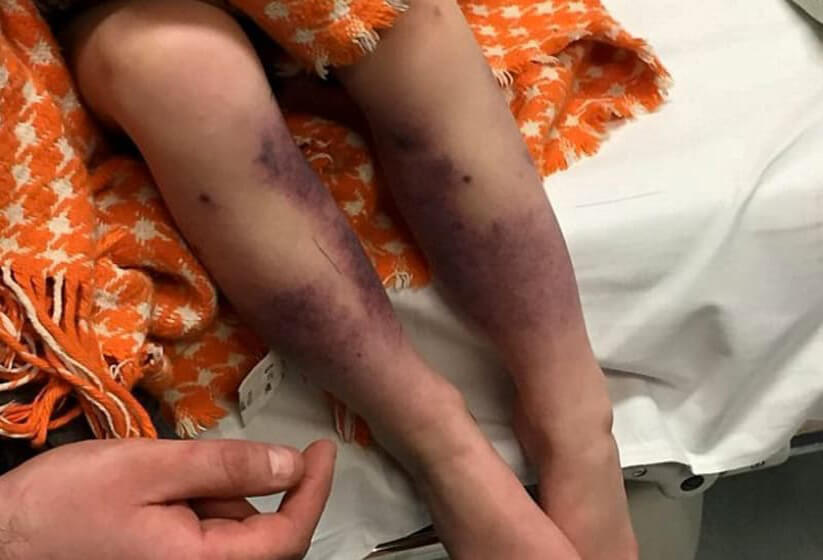As soon as Bo woke up having bruises on her lower limbs, her loved ones were surprised. The 4-year-old out of U.K had not hurt herself or carried out anything at all that would end up in this shock. Just exactly what in the world was going on?
It turned out that the small girl had a extremely uncommon problem known as purpura fulminans. What she was seeing on her hip and legs were bruises triggered by coagulation in her blood vessels. It’s an serious, unusual issue that is often dangerous.

The condition is caused by a protein C deficiency in the body. When the body is deficient in protein C, blood flows begins to coagulate. This leads to blood clots, which is what was causing Bo’s strange bruising.
A protein C deficiency is caused by genetic issues. It’s a relatively new condition, first identified by doctors in 1981. It’s a very rare condition, with only about 0.5% of the population carrying the genes that lead to a protein C deficiency. Because it’s so rare, few people have their protein C tested and doctors generally don’t consider it when treating patients.. That’s unfortunate, because purpura fulminans requires immediate medical attention to correct. If left untreated, the condition results in skin necrosis and disseminated intravascular coagulation.
The latter condition is extremely serious and can ultimately be fatal. Disseminated intravascular coagulation occurs when multiple blood clots form, restricting blood flow throughout the body. This results in damage to many vital organs, which can ultimately result in death.In Bo’s case, the doctors thankfully caught the condition quickly and properly diagnosed it. Still, they had bad news for the parents: there was a high likelihood that Bo’s legs would have to be amputated. The parents were stunned by this news because she had been a healthy girl up until that point. That’s because the skin necrosis caused by this condition can result in gangrene. If her legs became gangrenous, they would have to be removed.This little girl’s case was even rarer in that it was brought on by a case of the chicken pox. This normally benign infection caused an autoimmune disorder which prevented the body from making protein C. Doctors are unsure why this infection triggered that response in her body.
A team of physicians and researchers immediately got to work, trying to make Bo’s blood flow more efficient. They knew her legs, and potentially her life, were at stake. She underwent three skin grafts and had to spend almost three months in the hospital to recover.
Because it’s so rare, few people have their protein C tested and doctors generally don’t consider it when treating patients.. That’s unfortunate, because purpura fulminans requires immediate medical attention to correct. If left untreated, the condition results in skin necrosis and disseminated intravascular coagulation.
The latter condition is extremely serious and can ultimately be fatal. Disseminated intravascular coagulation occurs when multiple blood clots form, restricting blood flow throughout the body. This results in damage to many vital organs, which can ultimately result in death.In Bo’s case, the doctors thankfully caught the condition quickly and properly diagnosed it. Still, they had bad news for the parents: there was a high likelihood that Bo’s legs would have to be amputated. The parents were stunned by this news because she had been a healthy girl up until that point. That’s because the skin necrosis caused by this condition can result in gangrene. If her legs became gangrenous, they would have to be removed.This little girl’s case was even rarer in that it was brought on by a case of the chicken pox. This normally benign infection caused an autoimmune disorder which prevented the body from making protein C. Doctors are unsure why this infection triggered that response in her body.
A team of physicians and researchers immediately got to work, trying to make Bo’s blood flow more efficient. They knew her legs, and potentially her life, were at stake. She underwent three skin grafts and had to spend almost three months in the hospital to recover. Thankfully, with these medications and therapy, Bo was able to keep her legs. She was confined to wheelchair during this treatment, but is now able to walk normally now that her treatments are complete. Her parents are extremely thankful that they have their healthy little girl back.
But they also know that the underlying conditions that caused her purpura fulminans are still there. Bo will have to be carefully monitored by doctors to ensure that these problems don’t return. Hopefully, for her sake, Bo is able to lead a normal, healthy life.
Thankfully, with these medications and therapy, Bo was able to keep her legs. She was confined to wheelchair during this treatment, but is now able to walk normally now that her treatments are complete. Her parents are extremely thankful that they have their healthy little girl back.
But they also know that the underlying conditions that caused her purpura fulminans are still there. Bo will have to be carefully monitored by doctors to ensure that these problems don’t return. Hopefully, for her sake, Bo is able to lead a normal, healthy life.



 Freshsein
Freshsein